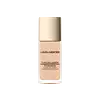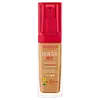What's inside
What's inside
 Key Ingredients
Key Ingredients

 Benefits
Benefits

 Concerns
Concerns

 Ingredients Side-by-side
Ingredients Side-by-side

Water
Skin ConditioningCyclopentasiloxane
EmollientIsohexadecane
EmollientGlycerin
HumectantCetyl PEG/PPG-10/1 Dimethicone
EmulsifyingButylene Glycol
HumectantPolyglyceryl-4 Isostearate
EmulsifyingHexyl Laurate
EmollientPEG-10 Dimethicone
Skin ConditioningDiphenyl Dimethicone
EmollientPolymethyl Methacrylate
Dimethicone
EmollientAluminum Starch Octenylsuccinate
AbsorbentSodium Hyaluronate
HumectantTocopherol
AntioxidantTocopheryl Acetate
AntioxidantTremella Fuciformis Sporocarp Extract
AntioxidantAscorbyl Glucoside
AntioxidantDisodium Stearoyl Glutamate
CleansingMethicone
EmollientOctyldodecanol
EmollientOctyldodecyl Neopentanoate
EmollientTetrahexyldecyl Ascorbate
AntioxidantAcrylates/Ethylhexyl Acrylate Copolymer
Magnesium Sulfate
Nylon-12
Aluminum Hydroxide
EmollientSilica
AbrasiveMica
Cosmetic ColorantAcetylated Glycol Stearate
EmollientDisteardimonium Hectorite
StabilisingBetaine
HumectantPhytantriol
HumectantCellulose Gum
Emulsion StabilisingHexylene Glycol
EmulsifyingDisodium EDTA
Laureth-21
CleansingAminomethyl Propanol
BufferingTin Oxide
AbrasivePhenoxyethanol
PreservativeCaprylyl Glycol
EmollientPotassium Sorbate
PreservativeTitanium Dioxide
Cosmetic ColorantCI 77491
Cosmetic ColorantCI 77492
Cosmetic ColorantCI 77499
Cosmetic ColorantWater, Cyclopentasiloxane, Isohexadecane, Glycerin, Cetyl PEG/PPG-10/1 Dimethicone, Butylene Glycol, Polyglyceryl-4 Isostearate, Hexyl Laurate, PEG-10 Dimethicone, Diphenyl Dimethicone, Polymethyl Methacrylate, Dimethicone, Aluminum Starch Octenylsuccinate, Sodium Hyaluronate, Tocopherol, Tocopheryl Acetate, Tremella Fuciformis Sporocarp Extract, Ascorbyl Glucoside, Disodium Stearoyl Glutamate, Methicone, Octyldodecanol, Octyldodecyl Neopentanoate, Tetrahexyldecyl Ascorbate, Acrylates/Ethylhexyl Acrylate Copolymer, Magnesium Sulfate, Nylon-12, Aluminum Hydroxide, Silica, Mica, Acetylated Glycol Stearate, Disteardimonium Hectorite, Betaine, Phytantriol, Cellulose Gum, Hexylene Glycol, Disodium EDTA, Laureth-21, Aminomethyl Propanol, Tin Oxide, Phenoxyethanol, Caprylyl Glycol, Potassium Sorbate, Titanium Dioxide, CI 77491, CI 77492, CI 77499
Water
Skin ConditioningDimethicone
EmollientCyclopentasiloxane
EmollientButylene Glycol
HumectantPEG-10 Dimethicone
Skin ConditioningAluminum Starch Octenylsuccinate
AbsorbentPhenoxyethanol
PreservativeSodium Chloride
MaskingDisteardimonium Hectorite
StabilisingDisodium Stearoyl Glutamate
CleansingDimethicone Crosspolymer
Emulsion StabilisingParfum
MaskingAlcohol Denat.
AntimicrobialAscorbyl Palmitate
AntioxidantGlycine Soja Oil
EmollientTocopherol
AntioxidantPropylene Glycol
HumectantPanthenol
Skin ConditioningAluminum Hydroxide
EmollientSilica
AbrasiveGlycerin
HumectantPyrus Malus Fruit Extract
Skin ConditioningSodium Hyaluronate
HumectantCucumis Melo Fruit Extract
Skin ConditioningPrunus Armeniaca Fruit Extract
Skin ConditioningPotassium Sorbate
PreservativeSodium Benzoate
MaskingBenzoic Acid
MaskingPantolactone
HumectantSorbic Acid
PreservativeBHT
AntioxidantCI 77891
Cosmetic ColorantIron Oxides
Mica
Cosmetic ColorantWater, Dimethicone, Cyclopentasiloxane, Butylene Glycol, PEG-10 Dimethicone, Aluminum Starch Octenylsuccinate, Phenoxyethanol, Sodium Chloride, Disteardimonium Hectorite, Disodium Stearoyl Glutamate, Dimethicone Crosspolymer, Parfum, Alcohol Denat., Ascorbyl Palmitate, Glycine Soja Oil, Tocopherol, Propylene Glycol, Panthenol, Aluminum Hydroxide, Silica, Glycerin, Pyrus Malus Fruit Extract, Sodium Hyaluronate, Cucumis Melo Fruit Extract, Prunus Armeniaca Fruit Extract, Potassium Sorbate, Sodium Benzoate, Benzoic Acid, Pantolactone, Sorbic Acid, BHT, CI 77891, Iron Oxides, Mica
 Reviews
Reviews

Ingredients Explained
These ingredients are found in both products.
Ingredients higher up in an ingredient list are typically present in a larger amount.
Aluminum Hydroxide is a form of aluminum. It can be naturally found in nature as the mineral gibbsite. In cosmetics, Aluminum Hydroxide is used as a colorant, pH adjuster, and absorbent.
As a colorant, Aluminum Hydroxide may add opacity, or reduce the transparency. Aluminum hydroxide is contains both basic and acidic properties.
According to manufacturers, this ingredient is an emollient and humectant. This means it helps hydrate the skin.
In medicine, this ingredient is used to help relieve heartburn and help heal ulcers.
There is currently no credible scientific evidence linking aluminum hydroxide in cosmetics to increased cancer risk.
Major health organizations allow the use of aluminum hydroxide in personal care products and have not flagged it as a carcinogenic risk at typical usage levels.
Learn more about Aluminum HydroxideAluminum Starch Octenylsuccinate is a synthetic powder used as an absorbent, thickener, and anti-caking agent.
As an absorbent, it is great at mattifying skin by soaking up the oil. This is why you'll find it in a range of products from makeup to moisturizers.
This ingredient is considered a modified starch. Starch can also be found naturally in plants.
One study from 1991 found that 5% of this ingredient enhanced titanium dioxide SPF by as much as 40%. The study found 1% titanium dioxide had a 5.6 SPF and adding 5% of aluminum starch octenylsuccinate boosted it to an SPF of 8.1
Although “aluminum” in an ingredient name can raise red flags for some consumers, the form and usage context matter significantly. For typical topical applications, there is no substantial evidence of health risks - such as cancer, neurotoxicity, or systemic “aluminum overload.”
Learn more about Aluminum Starch OctenylsuccinateButylene Glycol (or BG) is used within cosmetic products for a few different reasons:
Overall, Butylene Glycol is a safe and well-rounded ingredient that works well with other ingredients.
Though this ingredient works well with most skin types, some people with sensitive skin may experience a reaction such as allergic rashes, closed comedones, or itchiness.
Learn more about Butylene GlycolCyclopentasiloxane, or D5, is a silicone used to improve texture of products and trap moisture.
D5 is considered lightweight and volatile. Volatile means it evaporates quickly after application. Once evaporated, D5 leaves a thin barrier that helps keep skin hydrated.
It is also an emollient. Emollients help soften the skin and prevent water loss. Silicones create a silky texture in products. D5 helps other ingredients become more spreadable.
Studies show D5 is safe to use in skincare products. We recommend speaking with a skincare professional if you have concerns.
Learn more about CyclopentasiloxaneDimethicone is a type of synthetic silicone created from natural materials such as quartz.
What it does:
Dimethicone comes in different viscosities:
Depending on the viscosity, dimethicone has different properties.
Ingredients lists don't always show which type is used, so we recommend reaching out to the brand if you have questions about the viscosity.
This ingredient is unlikely to cause irritation because it does not get absorbed into skin. However, people with silicone allergies should be careful about using this ingredient.
Note: Dimethicone may contribute to pilling. This is because it is not oil or water soluble, so pilling may occur when layered with products. When mixed with heavy oils in a formula, the outcome is also quite greasy.
Learn more about DimethiconeDSG is used as a surfactant.
Surfactants are cleansing ingredients that help remove oil, dirt, and other impurities from the skin. They work by reducing surface tension between water and oils/dirt to allow them to be easily rinsed away.
Disteardimonium Hectorite comes from the clay mineral named hectorite. It is used to add thickness to a product.
It can also help stabilize a product by helping to disperse other ingredients.
Hectorite is a rare, white clay mineral.
Learn more about Disteardimonium HectoriteGlycerin is already naturally found in your skin. It helps moisturize and protect your skin.
A study from 2016 found glycerin to be more effective as a humectant than AHAs and hyaluronic acid.
As a humectant, it helps the skin stay hydrated by pulling moisture to your skin. The low molecular weight of glycerin allows it to pull moisture into the deeper layers of your skin.
Hydrated skin improves your skin barrier; Your skin barrier helps protect against irritants and bacteria.
Glycerin has also been found to have antimicrobial and antiviral properties. Due to these properties, glycerin is often used in wound and burn treatments.
In cosmetics, glycerin is usually derived from plants such as soybean or palm. However, it can also be sourced from animals, such as tallow or animal fat.
This ingredient is organic, colorless, odorless, and non-toxic.
Glycerin is the name for this ingredient in American English. British English uses Glycerol/Glycerine.
Learn more about GlycerinMica is a naturally occurring mineral used to add shimmer and color in cosmetics. It can also help improve the texture of a product or give it an opaque, white/silver color.
Serecite is the name for very fine but ragged grains of mica.
This ingredient is often coated with metal oxides like titanium dioxide. Trace amounts of heavy metals may be found in mica, but these metals are not harmful in our personal products.
Mica has been used since prehistoric times throughout the world. Ancient Egyptian, Indian, Greek, Roman, Aztec, and Chinese civilizations have used mica.
Learn more about MicaPeg-10 Dimethicone is silicone with conditioner and emulsifier properties. It mostly acts as an emollient in skincare and and humectant in haircare.
According to the manufacturer, acidic formulations decrease the stability of this ingredient. It works best in neutral or near neutral formulations.
Phenoxyethanol is a preservative that has germicide, antimicrobial, and aromatic properties. Studies show that phenoxyethanol can prevent microbial growth. By itself, it has a scent that is similar to that of a rose.
It's often used in formulations along with Caprylyl Glycol to preserve the shelf life of products.
Potassium Sorbate is a preservative used to prevent yeast and mold in products. It is commonly found in both cosmetic and food products.
This ingredient comes from potassium salt derived from sorbic acid. Sorbic acid is a natural antibiotic and effective against fungus.
Both potassium sorbate and sorbic acid can be found in baked goods, cheeses, dried meats, dried fruit, ice cream, pickles, wine, yogurt, and more.
You'll often find this ingredient used with other preservatives.
Learn more about Potassium SorbateSilica, also known as silicon dioxide, is a naturally occurring mineral. It is used as a fine, spherical, and porous powder in cosmetics.
Though it has exfoliant properties, the function of silica varies depending on the product.
The unique structure of silica enhances the spreadability and adds smoothness, making it a great texture enhancer.
It is also used as an active carrier, emulsifier, and mattifier due to its ability to absorb excess oil.
In some products, tiny microneedles called spicules are made from silica or hydrolyzed sponge. When you rub them in, they lightly polish away dead skin layers and enhance the penetration of active ingredients.
Learn more about SilicaSodium Hyaluronate is hyaluronic acid's salt form. It is commonly derived from the sodium salt of hyaluronic acid.
Like hyaluronic acid, it is great at holding water and acts as a humectant. This makes it a great skin hydrating ingredient.
Sodium Hyaluronate is naturally occurring in our bodies and is mostly found in eye fluid and joints.
These are some other common types of Hyaluronic Acid:
Learn more about Sodium HyaluronateTocopherol (also known as Vitamin E) is a common antioxidant used to help protect the skin from free-radicals and strengthen the skin barrier. It's also fat soluble - this means our skin is great at absorbing it.
Vitamin E also helps keep your natural skin lipids healthy. Your lipid skin barrier naturally consists of lipids, ceramides, and fatty acids. Vitamin E offers extra protection for your skin’s lipid barrier, keeping your skin healthy and nourished.
Another benefit is a bit of UV protection. Vitamin E helps reduce the damage caused by UVB rays. (It should not replace your sunscreen). Combining it with Vitamin C can decrease sunburned cells and hyperpigmentation after UV exposure.
You might have noticed Vitamin E + C often paired together. This is because it is great at stabilizing Vitamin C. Using the two together helps increase the effectiveness of both ingredients.
There are often claims that Vitamin E can reduce/prevent scarring, but these claims haven't been confirmed by scientific research.
Learn more about TocopherolWater. It's the most common cosmetic ingredient of all. You'll usually see it at the top of ingredient lists, meaning that it makes up the largest part of the product.
So why is it so popular? Water most often acts as a solvent - this means that it helps dissolve other ingredients into the formulation.
You'll also recognize water as that liquid we all need to stay alive. If you see this, drink a glass of water. Stay hydrated!
Learn more about Water